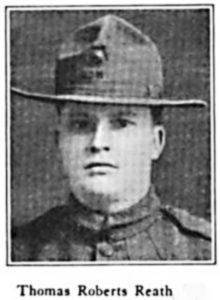When Keith Betten served as Church Warden at Riverton’s Christ Episcopal Church about twenty-five years ago, he wrote The Story of the Family of Christ Church, Riverton. Adapted from Chapter 5 of that work, this article holds some detail about the impact of the 1918 Influenza Pandemic on services at the church in November of that year.
Chapter 5 – 1915-1945
War and Peace
by Keith W. Betten, Warden

In the research which has been undertaken to prepare this short, serialized history of the Parish Family of Christ Church, this chapter has proven to be the most difficult to write for the very good reason that precious little has been unearthed in the way of source material. There are no detailed vestry minutes for this period and no historical sermons have been discovered to shed light on the 1920s and ’30s, decades which differed so very much, one from the other.
I think, however, that the experiences of the Parish Family over the course of the First World War, and during the bitter-sweet peace which came at its close may be used to capture the essence of the period under discussion. The Christ Church News (which seems to have ceased publication after 1920) has been used as a source of this description of the life of the Parish Family between 1915 and 1920.

The commencement of hostilities in far off Sarajevo in 1914 had attracted little attention at home. There was no official reference, at first, to the conflict in the pages of The News – only a poem entitled “War” appeared. It read, in part:
In This World which Christ died to ransom
Two thousand long years ago,
The fruit of our peaceful progress
Shall War’s bloody sickle mow?
O ye, who trust still His promise
And long for His peace in our day
By the Christ who died in torment,
Let us fall on our knees and pray!

Through 1915 and 1916 there was little hint of disruption in that “peaceful progress.” The practice of celebrating the Holy Eucharist twice each Sunday was introduced, a new organ was purchased, installed and dedicated and the Sunday School boasted a staff of fifteen to tend its 129 scholars. By October 1917, however, the names of 18 members of the Parish who were ”serving with the colors” were posted on the Church porch and all members of the Parish Family were asked to commend them to earnest prayer.
The winter of 1917-18 was a bitter one (the coldest it was reported, in 98 years), forcing the closure of the Parish House to conserve coal. The Girls’ Friendly Society, which was wrapping bandages for the Red Cross, met in a private home, and the Rector of the Parish traveled to “Camp Dix” two days each week to minister to the departing troops and the injured, returned.

By Easter 1918, twenty-seven of the Parish Family were serving their country; none to that date had been killed or wounded. A great patriotic Service was held in the Church on May 30th, a day that President Wilson and the Bishop had requested be observed as a day of “humiliation, prayer, and fasting.”
An overflow crowd, including the Mayor and Council, the Home Guards, the Boy Scouts, and the Red Cross, the latter all in uniform” filled the Church and spilled out onto the front lawn. “The procession, headed by the Cross and flag, filled all with a deep sense of pride and abiding hope” that the war would soon end, with Christian democracy triumphant. But at what price?

In June came the news that Thomas Roberts Reath, a son of the Parish and the grandson of long-time vestryman and warden Thomas Roberts had been killed in France; he was not yet 21. By fall, two others, Walter M. Kennedy and Raymond Pratt were likewise reported killed in action. The Parish Family, in deep mourning over these losses, was further traumatized by the onset of the great influenza epidemic of the autumn of 1918: the church was obliged to remain closed on three consecutive Sundays in October, a dreadful month which witnessed the death of eight of our communicants.

The anguish came, mercifully, to an abrupt end in November when Riverton was awakened at 4:30 on the morning of November 11, 1918, by the ringing of our Parish bell–the first in town to announce that the armistice had been signed. The war, at last, was over. Tears of joy and sorrow surely flowed together as the Parish Family gathered one Sunday that month to honor their dead and to dedicate the brass tablet which adorns the wall behind the eagle lectern to this day. It is a memorial to the late Thomas Roberts for his half-century of service to the Parish and “to his well-loved grandson, Thomas Roberts Reath, 1897-1918. Born and baptized in this Parish, Sergeant, U.S. Marines; killed in action, Bois de Belleau, France, June 12, 1918.”
[Surprisingly, and regretfully, little has been found concerning the experience of the Parish Family during the course of the Second World War; of the sons and daughters of the Parish who went off to defend the nation; or of the efforts, hopes and fears on the home front. Should it be discovered that written documentation of this aspect of our history cannot be found, an oral history, drawn from the recollections of those who remember those days would prove to be both an interesting and valuable venture and addition to our Parish story.]
